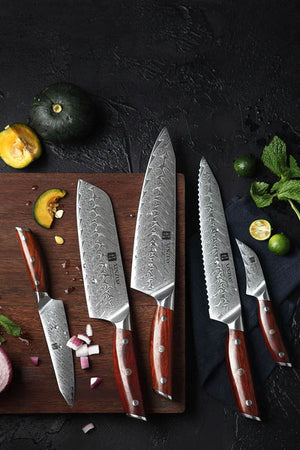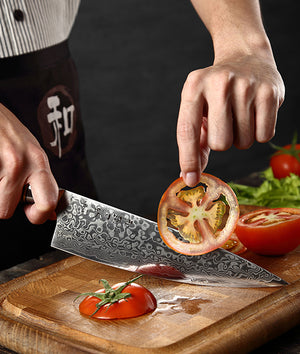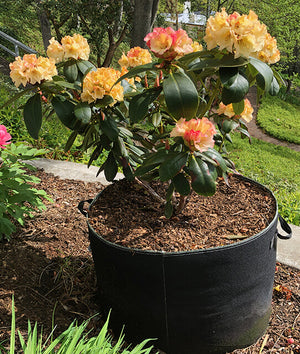
Must-Have Knives for Preparing a Christmas Dinner
If you’re a foodie, every dinner (and every single meal) is special – there’s just something about putting your creativity into something you can share with others that’s both special and rewarding. And, if you love cooking this much, that probably means you already have everything you need (or at least most of the things you need) to cook a delicious meal.
However, if that’s not you, and you prefer to stick to the basics during most of the year but want to pull out all the stops at Christmas time, you may need a little helping hand – and that’s okay! That’s what we’re here for.
One of the most important types of tools that you need to have in your kitchen is knives, and let us tell you, there are lots of different types of knives to choose from.
But, fear not! We’re here to walk you through the process – we’re going to give you our list of recommendations for all the best and most important knives that you’re going to need to prepare a traditional Christmas dinner. We’re talking about everything from turkey and gammon to roast potatoes, trifle, and a cheeky cheese board!
Stick around while we make your Christmas dinner prep a whole lot easier.
Typical Christmas Dinner Dishes
First, we need to talk about the dishes you’ll be preparing for your Christmas dinner. We’ve gone with a traditional Christmas dinner that consists of all the best and most delicious dishes – and, we’ve thrown in a few extra bits (some a little more unusual) just in case that’s your thing.
- Gammon
- Turkey
- Roast Potatoes
- Stuffing
- Various Other Vegetables (E.g. Carrots, Sweet Potatoes, Pumpkin, Brussel Sprouts Etc.)
- Seafood Dishes (E.g. Salmon, Prawns, Etc.)
- Sweet Pies (E.g. Pumpkin, Apple, Etc.)
- Trifle
- Fruit Cake
- Cheese Board
Now, let’s get on to the most important part – the knives.
Most Important Knives You’ll Need to Prepare a Delicious Christmas Dinner
We strongly believe that having the right knives for different functions and specific types of food is one of the best ways you can ensure that you’re cooking effectively and efficiently while enjoying the process too.
Now, you don’t necessarily need a different type of knife for every single thing you prepare – some knives are more versatile than others. So, it’s really all up to you, your preferences, and your budget.
So, to make things easier, we’ve split our list of knife recommendations into two parts – the first part is our more common, versatile knives that you almost definitely will need. And, the second part of our list is the more specialized options – if you’re wanting the fancy types of knives, or if you’re going to be making some of the more unusual types of Christmas dishes.
Without further ado, let’s dive right into the most important knives you’ll need to prepare a delicious Christmas dinner for your family and friends.
General Knives
Carving Knife
For most people, one of the most important (and delicious) parts of Christmas dinner is the meat – most commonly, that means turkey and gammon, but for some, that could also be roast chicken, duck, or roast beef.
Regardless of the type of meat you’re using – other than fish – a carving knife is always going to come in handy. It’ll allow you to create precise slices of meat at the thickness of your choice. Best of all, with a good carving knife, your sliced meat will look professional!
Here’s what makes a carving knife special:
- A long and narrow blade – between eight and 14 inches. This allows the knife to be used on both small and larger cuts of meat.
- Blades normally made from carbon or high-carbon steel for extra sharpness and durability.
- A pointed tip to allow for intricate carving and navigation around bones.
- A blade that is fairly flexible, also making it easier to work around bones and the natural shape of the meat.
Chef’s Knife
A chef’s knife is very commonly referred to as one of the most versatile knives, and for good reason. A carving knife can be used for anything from preparing vegetables to chopping up meat. You can use it mince herbs, cut up fruit – you name it. It’s suitable for chopping, slicing, dicing, and even some kinds of precision work.
These are the most important features of a chef’s knife:
- A medium-length to long blade – anywhere from six to twelve inches, with eight inches being the most common.
- Blade materials can vary, from stainless steel and high-carbon steel to Damascus steel or even ceramics.
- Broad, curved blade that’s ideal for rocking and chopping motions.
- A sharp, straight edge.
- A thick spine to allow you to scoop food (especially herbs).
- Full or partial tang (most often the former) – this influences the balance of the knife.
Utility Knife
A utility knife is one of the other most versatile knives commonly found in a kitchen, but if a chef’s knife is considered the large versatile knife, a utility knife is the smaller one. It’s a great tool to use for small and medium-sized tasks, like cutting up smaller vegetables (perhaps if you’re cutting your Brussel sprouts in half or cutting small carrots).
These are the main qualities that make a utility knife what it is:
- A short blade, anywhere from four to seven inches long.
- Either a straight or serrated blade.
- A tip that’s either round or pointed, depending on preference.
- Blade normally made from high-carbon steel, but could also be made from stainless steel or ordinary carbon steel.
- It can have full or partial tang, but having full tang isn’t as essential in a small knife.
Specialized Knives
Paring Knife
Paring knives aren’t often considered specialized knives, but we’ve put it in this category, because when it comes to cooking a Christmas dinner, it’s necessarily an essential tool for most people.
However, if you plan on doing something intricate that requires great precision, like deveining prawns for a seafood platter or creating beautiful garnishes for your dishes, a paring knife will come in really handy. Or, you could even use it for peeling and shaping small fruits or veggies.
This is what makes a paring knife good for precision:
- Short blade, about three or four inches long.
- A narrow, slightly curved blade.
- Can be made from stainless steel or high-carbon steel.
- Edge can be serrated or smooth, but the latter is more common.
Santoku Knife
When it comes to versatility, Santoku knives are often said to be right behind chef’s knives. The primary use of a Santoku knife is for slicing, dicing, and chopping vegetables, but the main difference is that a Santoku knife is Japanese in style of design, and it has a unique shape.
If you’re going to be cooking up a storm on Christmas, a Santoku knife is probably the best option for working with vegetables – most importantly, the size is ideal, and it has a Granton edge to prevent slices from getting stuck to the knife. So, if you want to chop up your potatoes, carrots, pumpkin, butternut, or anything else, a Santoku knife is a great option.
Here’s what makes it unique:
- It has a five- to seven-inch-long blade – shorter than a chef’s knife.
- Flat cutting edge and a unique shape that vaguely resembles a sheep’s foot (or so they say).
- Granton edge – divots on the blade to prevent friction and food from sticking to the blade.
- Blade is fairly wide, more so than a chef’s knife.
It should be noted, however, that one of the main differences between a chef’s knife and a Santoku knife is that the latter isn’t quite as robust, so it can’t be used with meat.
Sakimaru Knife
You’ll only need a Sakimaru knife at Christmas time if you’re going to be doing fish – although it’s not necessarily the most common, there are actually traditions that call for eating fish on Christmas. For instance, some Italian Americans indulge in “the Feast of the Seven Fish”, while other people just prefer lighter food.
So, if you’re going to be getting involved with fish, you need a suitable knife, and a Sakimaru knife is an excellent versatile choice so that you don’t need several different types of fish knives. Of course, there are several other options too – sashimi knives, filleting knives, and so on.
Here’s what makes a Sakimaru knife a great fish knife:
- Slender, long blade with a dramatic curve towards the tip.
- The tip of the blade is often pointed and acute.
- Single bevel edge to enhance precision.
- Generally made from super high-quality materials like high-carbon steel.
- Slightly flexible blade to contribute to precision.
Butter Knife
Whether or not you need a butter knife for Christmas dinner all depends on your preferences, but for some people, there’s always got to be some kind of delicious fresh bread or crackers with a cheese board. And if you’re having either of those, butter is a must.
Butter knives are pretty basic, but it’s always a good idea to use one for spreading butter. Here’s what makes it unique:
- A flat, rounded tip.
- A dull edge (not sharp), because it doesn’t need sharpness.
- Can be made from various materials but stainless steel and silver are most common.
Edge can be serrated or smooth, but either way, it’s not sharp.
Cheese Knife
Last but not least, if you want to end your Christmas meal with a bang and go all out, there’s nothing quite like a delicious cheese board.
Now, you get two different types of cheese knives – namely, one for hard and one for soft cheese.
These are he qualities of a cheese knife that make it special:
- Soft cheese knives may have serrated edges and hard cheese knives often are more sturdy and broad.
- Blades are normally made from stainless steel.
- Some cheese knives have divots on the blade (Granton edge) so slices don’t get stuck – especially soft cheese knives.
- Some cheese knives have a pronged tip for picking up cheese.
Final Thoughts on Must-Have Knives for Preparing a Christmas Dinner
Well, there you have it! The most important knives to have at your disposal for preparing the best Christmas dinner.
In our opinion, the most important of the lot are the Chef’s knife, a utility knife, a carving knife, and a butter knife. But, a paring knife, Santoku knife, Sakimaru, and a cheese knife will also come in handy.
So, Merry Christmas and happy cooking!


